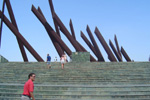
Trips from Cuban Resorts |
|
The intent of this page is easy - to provide the viewer with a sample of what we have seen and experienced on our trips to Cuban resorts. |
|
We stayed at Brisas Guardalavaca for two weeks in 2005, March 18 to April 1. We had a great time and
during our stay we took advantage of two tours; one commercial tour to Santiago de Cuba, the other was
a privately organized tour to Banes. This page will feature photos of places we visited off the resort. |
- Guardalavaca -
- Santiago de Cuba -
- Banes -
 Like many tourists, we wanted to see the "real". Cuba as resorts are just that - resorts. We had done considerable
research on Debbie's and learned of a certain tour guide in the area and sought him out. Although the deal we arrived
at was on the up-and-up and he provided a Cubanacan car, he asked that we not use his name on the internet. In his
previous career he had taught English at the University of Havana but found he could provide a better life for his
family as a tour guide. We four tourists, one of which was a high school teacher, had brought quite a bit of grade
school material so our guide included a school visit in our tour.
Like many tourists, we wanted to see the "real". Cuba as resorts are just that - resorts. We had done considerable
research on Debbie's and learned of a certain tour guide in the area and sought him out. Although the deal we arrived
at was on the up-and-up and he provided a Cubanacan car, he asked that we not use his name on the internet. In his
previous career he had taught English at the University of Havana but found he could provide a better life for his
family as a tour guide. We four tourists, one of which was a high school teacher, had brought quite a bit of grade
school material so our guide included a school visit in our tour.
|
 Banes is a simple town. Cuba's last dictator, Fulgencio Batista, whom Castro defeated in 1959 in the Cuban rebellion,
was born in Banes. On the left is a good example of a 1958 Plymouth. There wasn't much available in the market. We
obviously had missed the day or days when local produce is available.
Banes is a simple town. Cuba's last dictator, Fulgencio Batista, whom Castro defeated in 1959 in the Cuban rebellion,
was born in Banes. On the left is a good example of a 1958 Plymouth. There wasn't much available in the market. We
obviously had missed the day or days when local produce is available.After the market, seen here on the right, our guide "set us free" to walk several blocks by ourselves. He told us where he would wait for us and drove off. It was an odd experience as our Spanish was limited to guidebook phrases. We were immediately "befriended" by several young Cubans who offered to be our guides. We accepted one young fellow and he told us about his city, about the stores and businesses, where the museum was, and brought us to our guide. A tip of 2 CUC brought a bright smile.  Our guide wanted us to experience that walking alone in a little Cuban town was safe and although it was somewhat unsettling for the first couple of minutes, we enjoyed the experience. Cubans quite like Canadians and do appreciate that we have normal international relations. They all know who Pierre Trudeau was! Check out this link for more information about Batista; History of Cuba.com |
2007 Havana - From Varadero
|
We finally managed to have a winter holiday in Varadero, February 8-22, 2007, and it was worth the wait. The weather could have been warmer as we managed to be there during one of the cooler and wetter Februarys in recent memory. However, as it was -30C or colder on the prairies, it was a most welcome break. Veradero is completely different than Guardalavaca. Veradero, at least what is visible to the average tourist, seems more prosperous. The long penninsula is dotted with upwards of 50 resorts, a couple of golf courses, and a marina on the inside shore. A few examples of former estates still stand - reminders of the lavish lifestyle enjoyed by the rich and famous (or infamous) before the Revolution. |
- Havana -



































